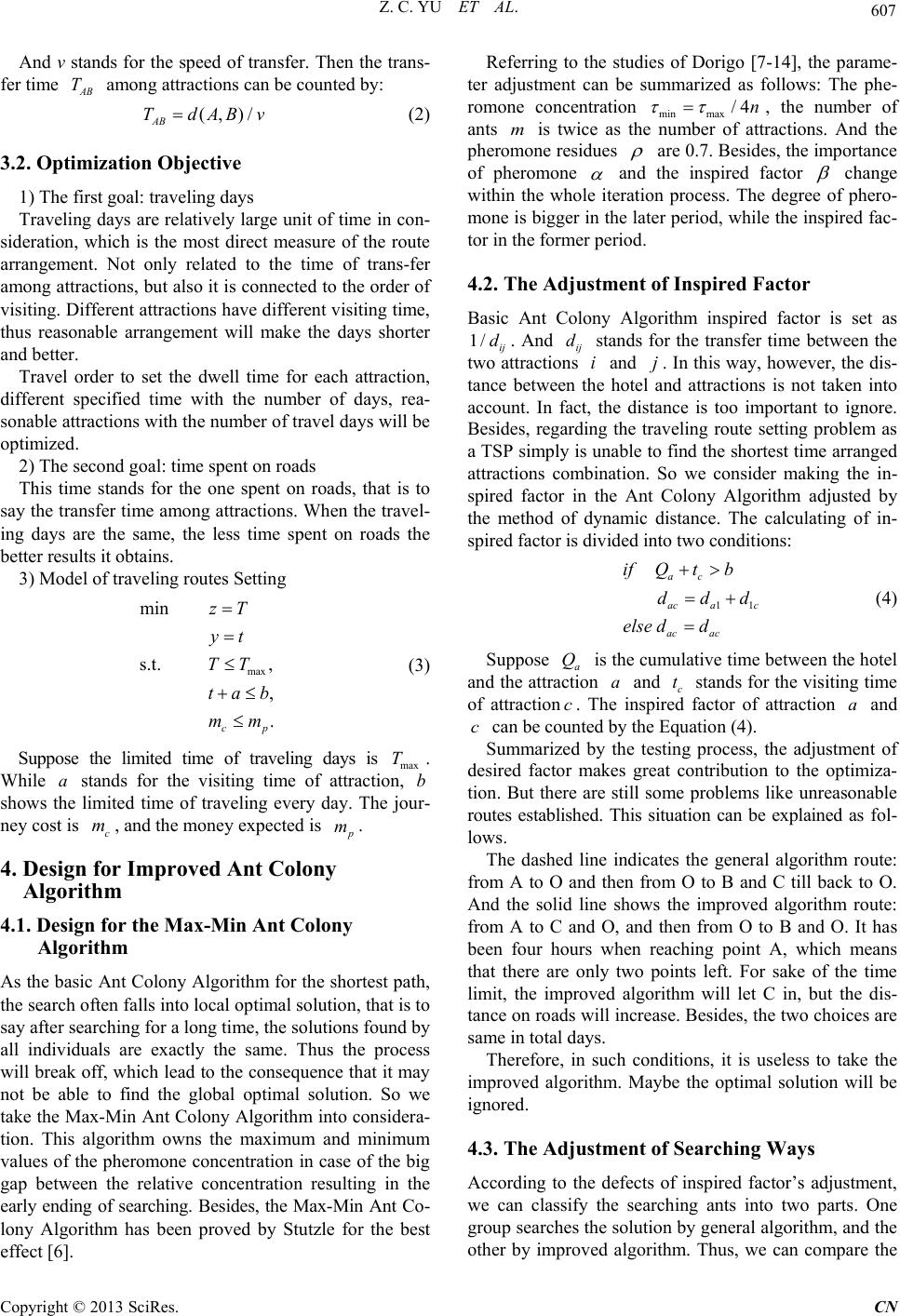
Z. C. YU ET AL.
Copyright © 2013 SciRes. CN
And v stands for the speed of transfer. Then the trans-
fer time
among attractions can be counted by:
(2)
3.2. Optimization Objective
1) The first goal: traveling days
Traveling days are relatively large unit of time in con-
sideration, which is the most direct measure of the route
arrangement. Not only related to the time of trans-fer
among attractions, but also it is connected to the order of
visiting. Differen t attractions have differ ent visiting time,
thus reasonable arrangement will make the days shorter
and better.
Travel order to set the dwell time for each attraction,
different specified time with the number of days, rea-
sonable attractions with the number of travel days w ill be
optimized.
2) The second goal: time spent on roads
This time stands for the one spent on roads, that is to
say the transfer time among attractions. When the travel-
ing days are the same, the less time spent on roads the
better results it obtains.
3) Model of traveling routes Setting
max
min
s.t. ,
,
.
cp
zT
yt
TT
tab
mm
=
=
≤
+≤
≤
(3)
Suppose the limited time of traveling days is
.
While
stands for the visiting time of attraction,
shows the limited time of traveling every day. The jour-
ney cost is
, and the money expected is
.
4. Design for Improved Ant Colony
Algorithm
4.1. Design for the Max-Min Ant Colony
Algorithm
As the basic Ant Colony Algorithm for the shortest path,
the search often falls into local optimal solution, that is to
say after searching for a long time, the solutions found by
all individuals are exactly the same. Thus the process
will break off, which lead to the consequence that it may
not be able to find the global optimal solution. So we
take the Max-Min Ant Colony Algorithm into considera-
tion. This algorithm owns the maximum and minimum
values of the pheromone concentration in case of the big
gap between the relative concentration resulting in the
early ending of searching. Besides, the Max-Min Ant Co-
lony Algorithm has been proved by Stutzle for the best
effect [6].
Referring to the studies of Dorigo [7-14], the parame-
ter adjustment can be summarized as follows: The phe-
romone concentration
, the number of
ants
is twice as the number of attractions. And the
pheromone residues
are 0.7. Besides, the importance
of pheromone
and the inspired factor
change
within the whole iteration process. The degree of phero-
mone is bigger in the later period, while the inspired fac-
tor in the former period.
4.2. The Adjustment of Inspired Factor
Basic Ant Colony Algorithm inspired factor is set as
. And
stands for the transfer time between the
two attractions
and
. In this way, however, the dis-
tance between the hotel and attractions is not taken into
account. In fact, the distance is too important to ignore.
Besides, regarding the traveling route setting problem as
a TSP simply is unable to find the shortest time arranged
attractions combination. So we consider making the in-
spired factor in the Ant Colony Algorithm adjusted by
the method of dynamic distance. The calculating of in-
spired factor is divided into two conditions:
11
ac
ac ac
ac ac
if Qtb
ddd
else dd
+>
= +
=
(4)
Suppose
is the cumulative time between the hotel
and the attraction
and
stands for the visiting time
of attraction
. The inspired factor of attraction
and
can be counted by the Equation (4).
Summarized by the testing process, the adjustment of
desired factor makes great contribution to the optimiza-
tion. But there are still some problems like unreasonable
routes establish ed. This situation can be explained as fol-
lows.
The dashed line indicates the general algorithm route:
from A to O and then from O to B and C till back to O.
And the solid line shows the improved algorithm route:
from A to C and O, and then from O to B and O. It has
been four hours when reaching point A, which means
that there are only two points left. For sake of the time
limit, the improved algorithm will let C in, but the dis-
tance on roads will increase. Besides, the two choices are
same in total days.
Therefore, in such conditions, it is useless to take the
improved algorithm. Maybe the optimal solution will be
ignored.
4.3. The Adjustment of Searching Ways
According to the defects of inspired factor’s adjustment,
we can classify the searching ants into two parts. One
group searches the solution by general algorithm, and the
other by improved algorithm. Thus, we can compare the